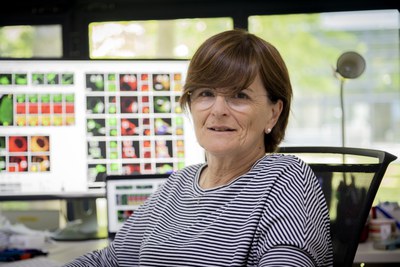Principal Investigator
Cell Biology and Disease Mechanisms Program Coordinator
Other positions:
Professor of Biology, Department of Molecular Medicine and Medical Biotechnology, University of Naples "Federico II"
Antonella De Matteis obtained her M.D. degree at the University of L’Aquila, where she completed her residencies in Internal Medicine and in Endocrinology. In 1988 she co-founded the Consorzio Mario Negri Sud Research Institute, a research center with the aim of training researchers in the South of Italy, where she also was a researcher at the Laboratory of Neuroendocrinology. In 1992, she became Head of the Secretion Physiopathology Lab at CMN Sud. In 2009, she moved to TIGEM to start a new laboratory and continue her research. Since 2011, she has been Director of the Cell Biology Program at TIGEM. In 2016, she was awarded an ERC Advanced Grant (Systems Biology of Membrane Trafficking - SYSMET). She is currently Full Professor of Biology at the Federico II University of Naples, and a Faculty Member of both the European School of Molecular Medicine (SEMM) and of the Open University PhD Programme in Human Genetics. For the past 5 years, she has been invited as plenary/keynote lecturer in over 30 different prestigious meetings and advanced schools both in Europe and in the USA.
The molecular mechanisms behind membrane trafficking
Membrane trafficking maintains cell organization and intercellular communication. Its important role is confirmed by the serious consequences that result from its disruption, such as those caused by inherited defects affecting components of membrane trafficking machineries. Over the years, we have investigated the interplay between signalling and membrane trafficking, in particular at the Golgi complex, a central sorting station in membrane trafficking pathways. Studying the role of phosphoinositide, we established a link between the GTPase ARF and the regulation of phosphoinositide metabolism by identifying a specific PI4 kinase isoform as a novel ARF effector. Among the phosphoinositide effectors we identified at the Golgi we have shown that FAPP proteins are involved in Golgi-to-plasma membrane trafficking and glycosphingolipid synthesis at the Golgi thanks to FAPP2-operated non-vesicular transport of glucosylceramide.
Membrane contact sites (MCSs) are areas of close apposition between the membranes of two organelles. MCSs most frequently involve the endoplasmic reticulum (ER) and another organelle such as mitochondria or the Golgi. Recently, we established a new FRET approach that has enabled us to identify molecular determinants coupling lipid exchange and cargo exit with maintenance of ER-Golgi MCSs. In so doing we identified not only tethering proteins such as VAPs and ORP10 but also that FAPP1 regulates PI4P levels at ER-Golgi MCSs and influences the levels of specific secreted proteins such as ApoB100.
One of our group’s missions is to apply our knowledge of membrane trafficking to understand the cellular and molecular pathogenesis of Mendelian disorders that arise from defects in membrane trafficking machinery, as well as identifying candidate drug targets. Oculocerebrorenal syndrome of Lowe (OCRL), or Lowe syndrome, is a rare X-linked genetic disease caused by mutations in the ocrl1 gene that is characterized by congenital cataracts, renal Fanconi’s syndrome (low molecular weight proteinuria, tubular acidosis) and mental retardation. OCRL1 is a PI(4,5)P2 5-phosphatase, and we have shown that its activity is required for different trafficking pathways that intersect early endosomes, including that of megalin, which controls protein reabsorption in proximal tubular cells at the kidney. Non-functional OCRL causes deregulation of actin assembly and the accumulation of PI(4,5)P2 at early endosomes which inhibits autophagosome-lysosome fusion. We have screened small molecule libraries looking for correctors of the cell phenotypes induced by the loss of OCRL and we are currently testing these correctors in mouse models for Lowe syndrome.
Amyotrophic lateral sclerosis 8 (ALS8) belongs to a heterogeneous group of progressive neurodegenerative disorders characterized by the death of motor neurons. ALS8 is caused by mutations in VAPB, a protein that acts at multiple contact sites, including ER-Golgi MCSs. We found that a depletion of VAPB results in an increase in Golgi- and acidic vesicle-localized PI4P associated with reduced neurite extension in a differentiated motor neuron cell line, which can be rescued by depleting PI4P levels.
Viral replication/propagation and membrane trafficking. SARS-CoV-2 and other coronaviruses share common mechanisms to extensively rearrange cellular membranes into replication organelles for RNA synthesis, and viral RNA and proteins subsequently assemble virions that follow the secretory pathway for cellular exit. We are using our longstanding experience in the membrane trafficking field to understand the mechanisms underlying these phenomena and to identify potential leads for broad antiviral agents.
- The role of NSP6 in the biogenesis of the SARS-CoV-2 replication organelle. Nature, 2022
- Vesicular and non-vesicular transport feed distinct glycosylation pathways in the Golgi. Nature, 2013
- Sedlin controls the ER export of procollagen by regulating the Sar1 cycle. Science, 2012
- Mendelian Disorders of membrane trafficking. New England Journal of Medicine, 2011
- Glycosphingolipid synthesis requires FAPP2 transfer of glucosylceramide. Nature, 2007
Complete List of Published Work in My Bibliography
Quote
My work has focused on the molecular mechanisms controlling intracellular membrane trafficking, a process that is crucial for the maintenance of cell organization, organelle homeostasis, and for intercellular communication. In recent years, our research has aimed to develop therapeutic strategies to cure inherited diseases.
Additional Funding
- FNIH - Monitoring and piloting the intracellular trafficking of AAVs in control and rare disease cell models (2022-2024)
- Dissecting the molecular mechanisms regulating MHC- trafficking and downregulation in cancer cells (2023-2024), AIRC
- SYSMET - Systems Biology of Membrane Trafficking (2016-2022), European Research Council – AdV
- Targeting the membrane contact sites to control local pools of PI4P, a phosphoinositide with an emerging role in cancer (2018-2022), AIRC
- FNIH - Monitoring and piloting the intracellular trafficking of AAVs in control and rare disease cell models (2022-2024)














